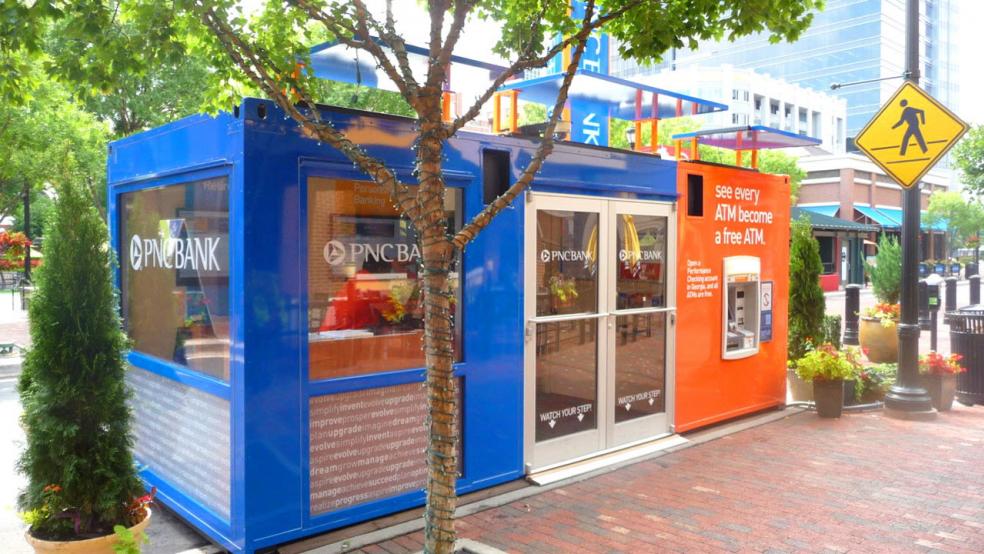In the post financial crisis world, the words “big” and “bank” have become almost inseparable. But even the biggest financial institutions today are rapidly scaling back one very public aspect of their business: branch offices.
Related: Americans Are So Over Bank Branches
The number of bank branches in the U.S. fell by nearly 1,500 last year, and many of the ones opening up are getting a new, smaller look. With millions of Americans taking up banking by smartphone last year alone, emerging technologies are altering the way banks and consumers interact, and the demand for in-person transactions is disappearing. Gone are the days of paper deposit slips, long lines, and, in some cases, even vaults. While reducing the size of their branch offices helps banks cut their costs, it can also open access to places where a traditional branch is economically infeasible.
In April, Wells Fargo opened an experimental outlet in Washington, D.C., that was designed from the ground up to accommodate new technologies while eliminating space-wasting elements like racks of paper forms and back offices. With smartphones or tablets able to put checks in customer accounts, who needs deposit slips?
Wells Fargo’s 14th and U Streets, Northwest, office covers just 2,000 square feet – about half the size of a traditional branch. Its ATMs dispense $1, $5, $20, and $100 bills, not just $20s, and can accept cash deposits. There’s a wireless hotspot for customers and the tablet-wielding employees aren’t confined to teller cages or cubicles.
The bank is thinking smaller, too. In May, it opened a 250 square-foot branch inside a Safeway grocery store. The mini office offers all the same technological and design elements of a larger branch. And it isn’t done: More will open in the Washington area late this year, according to Mike Golden, president of the San Francisco-based bank’s greater Washington region.
Wells Fargo says smaller branches will better serve its customers, but the shrinkage also cuts costs. Post-crisis reforms have squeezed revenues amid a period of slow economic growth, so bankers are looking everywhere for savings. Smaller footprints mean lower rent and construction expenses, while new technology can reduce back-office work so branches need fewer workers.
Many customers may never notice. Millions of Americans used mobile-banking applications for the first time last year – 74,000 new users a day, according to the U.S. Consumer Financial Protection Bureau. Armed with a cell phone, tablet or personal computer, consumers can avoid branch visits most if not all the time.
Related: Pope Francis Fires His Bankers…Again
Pittsburgh-based PNC Bank has taken things a step further. Its first “pop-up” branch opened last year in downtown Atlanta’s Atlantic Station neighborhood and stayed for just three months before being packed up. Now it’s in Chicago. Measuring just 20’ by 8’, the portable bank comes with much of the same technology seen in Wells Fargo’s mini branches, including smarter ATMs and tablet-toting employees who demonstrate mobile banking apps. But the bank doesn’t expect physical branches to completely disappear.
Emerging technology "has not diminished the importance of those face-to-face conversations that many customers seek and require when dealing with more complex banking issues, such as home loans,” said Marcey Zwiebel, a PNC spokeswoman. But she said only two in 10 PNC customers use a branch for primary banking and plans call for many offices to shrink by almost half.
“The cost of a smaller branch is a third of a traditional branch in construction and maintenance," Zwiebel said, adding that staff levels vary. The savings, she said, let PNC "make more investments and focus on enhancements of our current technology, as well as developing new technology that will benefit our customers."
The pop-up branch’s low overhead and the lack of a sustained financial commitment tied to a permanent office help PNC generate brand awareness in the Southeast, a largely untapped market for the bank, without adding much risk.
Well Fargo and PNC aren’t alone in tinkering with branch models and technologies. Last year, Bank of America rolled out a system of virtual tellers who confer with customers over video links. JPMorgan Chase’s new branches are much smaller than those built just a few years ago, and Citibank is considering similar shrinkage. Bank of the West, meanwhile, is trying out mini branches where a central machine handles the cash and a “teller pod” replaces the usual row of service windows.
Related: Finally! Big Investors Declare War on Big Banks
What this shrinkage means for customer service remains to be seen.
While technology is remaking the face of banking, there’s still a lot to be said for a physical presence in a community, according to Todd Barnhart, a PNC Bank executive vice president in charge of branches.
"Convenience to home remains the No. 1 reason that consumers choose their primary bank, but they are using branches very differently today," Barnhart said in a statement about the portable office trial. "This pop-up branch is a creative way to bring banking to customers and help them experience the innovative solutions we offer."
John Stephens is a Los Angeles-based writer and editor. He covers banking and finance for NerdWallet and spends his spare time collecting pudding labels to accrue airline miles. Follow him on Twitter: @ItsJohnStephens
Top Reads from The Fiscal Times:
- Americans Buy Nearly 1,500 McDonald's Burgers a Minute
- How Hookers and Drug Dealers Could Boost US GDP
- Wolf of Wall Street Says He’ll Make $100M This Year




